Table of contents
- Basics: top speed What happens at top speed?
- This happens in the engine and transmission
- The data
- Intake stroke
- Compression stroke
- Work cycle
- Exhaust stroke
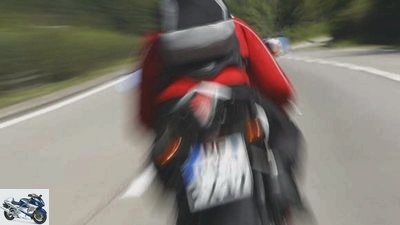
jkuenstle.de
counselor
workshop
Basics: What happens at top speed?
Basics: top speed
What happens at top speed?
At almost 300 kilometers an hour, the wind pressure is enormous, all muscles in the body are tense, adrenaline everywhere. A look inside the engine, however, reveals where the real thing is at full throttle. look for yourself.
01/10/2011
Three-lane motorways look like narrow streets in the old town that are only passable in one lane when the super sports car’s speedometer needle approaches the 300 km / h mark. Anyone who twitches now may tear the motorcycle up and fly off – maybe for the last time. The tachometer looks almost red, the color of your own face is no better either. Full concentration and a long view ahead are essential for the driver when he is using the full power of the engine. However, your own performance when driving on the Autobahn is nothing compared to the loads that the engine and transmission have to withstand. 2Rader is dedicated to the tortures that we do to our engines at full throttle. As a test copy, we chose the 2009 model of the Yamaha YZF-R1 and started looking for speeds, temperatures and Newton meters. And found more of it than we dared imagine.
This happens in the engine and transmission
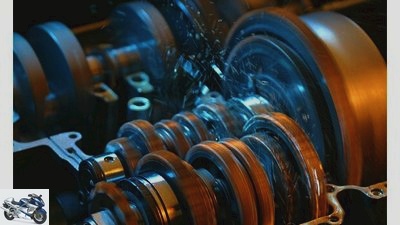
archive
The oil is still splashing; at higher speeds it begins to steam.
The power generated in the engine by the combustion pressure is transferred to the crankshaft via the connecting rod. Everything is rotating in the backyard of Hell. The crankshaft rotates with 13500 revolutions per minute at high speed in the Yamaha R1, that is a brisk 225 revolutions per second. It continues via the gears of the primary drive to the clutch. This still rotates at 8930 rpm. At the same time, the torque increases from 111 Newton meters on the crankshaft to tight 168 on the clutch. However, even with the best lubrication, the friction of the gears eats up a little power. Around two percent is lost on the way from the crankshaft to the clutch. Nevertheless, the sheer power of the material is still a real problem. For example, the flanks of the gear wheels of the sixth gear are pressed together with a force of more than 5000 Newtons. This is why specially coated surfaces are in demand here so that material breakouts – known as pitting – are avoided.
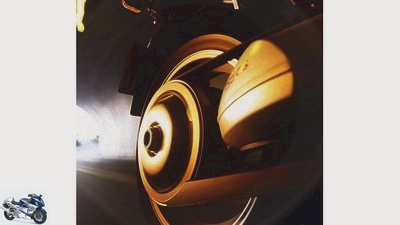
archive
The asphalt burns at full throttle.
The torque escapes into the open via the output shaft. The pinion rotates at top speed with 7036 revolutions, the torque is a remarkable 213 Newton meters. So no easy task for the final drive, which now has to transfer the power to the rear wheel.
As a rule, a chain that is basically very filigree has to withstand the loads, sometimes a cardan drive or, as shown here, a toothed belt takes over the task. Whether steel or rubber, what counts is resistance: almost half a ton pulls on a chain or belt at high speed, and when the gas is torn open in the low gears it is even more than a ton that the final drive has to withstand. The drive itself rushes at 110 km / h over the pinion and sprocket. The end of the line is big and round: the rear tire has to bring the fireworks onto the road from the front. The torque has increased with each reduction and is now a mighty 589 Newton meters. And the contact area between the tire and the asphalt is only a few square centimeters.
The data
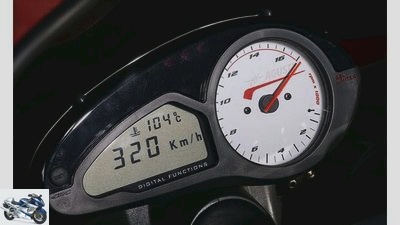
archive
The 104 degrees of the cooling water appear ridiculous compared to the inside of the engine.
Calculation basis: Four-cylinder, displacement 998 cm³, bore 78 mm, stroke 52.2 mm (Yamaha YZF-R1, model 2009)
Maximum power: 173 HP on the crankshaft and 159 HP on the rear wheel
Max. Torque: 111 Nm on the crankshaft
Max. Speed crankshaft: 13500 / min, corresponds to 225 / sec
Speed clutch: 8930 rpm (torque 168 Nm)
Engine sprocket speed in 6th gear: 7036 / min (torque 213 Nm)
Rear wheel speed: 2522 rpm (torque 589 Nm)
Medium piston speed: 23.5 m / s, corresponds to 84.6 km / h
Max. Piston speed: 37.6 m / s, corresponds to 135.4 km / h
Mean piston deceleration: 27083 m / s², corresponds to 2761g
Circumferential speed of the chain: 110 km / h
Actual circumferential speed on the tire: 295 km / h
Max. Temperature at the rear tire: about 100 degrees Celsius on the surface
Intake stroke
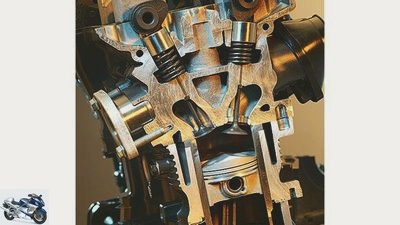
archive
Intake stroke
At 12,000 rpm, the narrow cylinder is like in the open air space. The downward movement causes the piston to suck in fresh gas at supersonic speed through the inlet duct (right).
Compression stroke
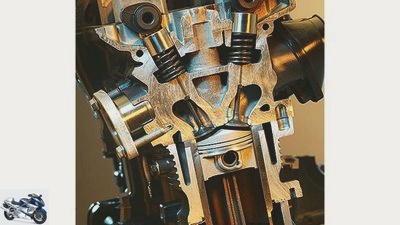
archive
Compression stroke
In the case of a 1000 four-cylinder, the piston compresses the cylinder volume from 250 cm³ to around 20 cm³ by moving upwards. The intake air heats up to around 500 degrees Celsius.
Work cycle
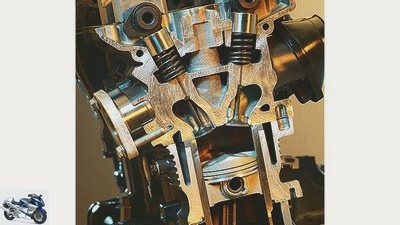
archive
Work cycle
The mixture burns. The temperature rises suddenly to 3000 degrees Celsius, the pressure to 90 bar. The piston area is loaded with around 3.7 tons – roughly the weight of a fully loaded sprinter.
Exhaust stroke
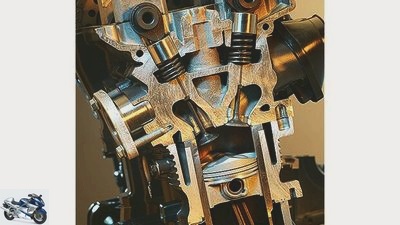
archive
Exhaust stroke
The upward movement of the piston presses the exhaust gases through the exhaust duct (left), whereby the valves heat up to over 800 degrees Celsius until they burn red.
Related articles
-
Suzuki Hayabusa: 190 PS, 299 km-h top speed
News 2022 New motorcycle items for 2022 Suzuki 40 pictures Suzuki 1/40 Suzuki brings the third generation of the Hayabusa in 2021. It all started in…
-
Bilski motorcycles Torque and speed Torque and speed Minimax Worlds collide when a sports engine is supposed to tease out top performance from a minimal…
-
Bilski motorcycles Comparison test: KTM 990 Super Duke, Moto Morini Corsaro 1200 Veloce, Triumph Speed Triple, Yamaha FZ1 Comparison test: KTM 990…
-
White Motorcycle Concepts WMC250EV: electric speed record
White Motorcycle Concepts 15th pictures White Motorcycle Concepts 1/15 White Motorcycle Concepts wants the world speed record for electric motorcycles….
-
Triumph Speed Triple 1200 RS: Almost everything new
News 2022 New motorcycle items for 2022 Triumph Motorcycles 44 pictures Triumph Motorcycles 1/44 The new Speedy 1200 RS has new headlights that are very…
-
Triumph Speed Triple 1200 RS top test 2021
Arturo Rivas 28 pictures Arturo Rivas 1/28 In the top test with the Triumph Street Triple 1200 RS, the testers clearly had fun. Arturo Rivas 2/28…
-
Basics: This is how silencers are made
archive accesories Exhaust & silencer Basics: This is how silencers are made Basics: This is how silencers are made Visiting the Shark company 2Wheels at…
-
Basics: chain, cardan, toothed belt
archive counselor workshop Basics: chain, cardan, toothed belt Basics: chain, cardan, toothed belt Advantages and disadvantages explained Toothed belt,…
-
Aral counselor traffic & business Basics: alternative drives Basics: alternative drives What could drive us in the future Refueling was yesterday. And…
-
Fotolia; Swanepoel Sports & scene Motorsport Why are we so keen on speed Background head cinema Why are we so keen on speed? Content of Speed is a kick…